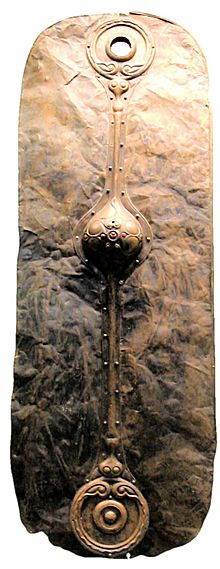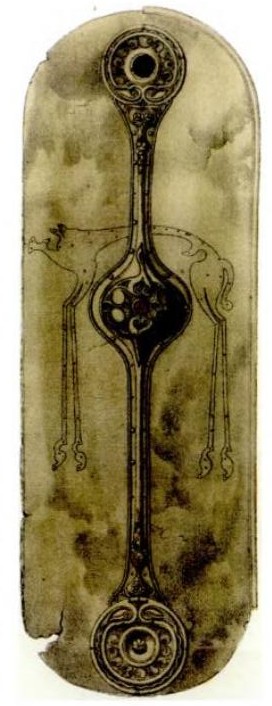Witham Shield facts for kids
Quick facts for kids Witham Shield |
|
|---|---|
 |
|
| Material | Bronze |
| Size | 1.13 m long |
| Created | 400-300 BC |
| Discovered | in the River Witham near Lincoln |
| Present location | British Museum, London |
| Registration | 1872,1213.1 |
The Witham Shield is a super cool bronze shield from the Iron Age, made around 400 to 300 BC. It's known for its fancy La Tène style. People found this amazing shield in the River Witham in Lincolnshire, England, back in 1826. It was near the villages of Washingborough and Fiskerton.
Later digs nearby found old wooden posts, maybe from a walkway, and other cool stuff like swords and spears. The shield is now kept safe at the British Museum in London.
Contents
What the Shield Looks Like
The Witham Shield is a great example of Celtic art from the Iron Age. The bronze surface looks like it was changed or fixed up over time. The most noticeable part is the round bump in the middle, called a boss. This boss was important because it let the person holding the shield grip it easily.
Originally, a shape of a long-legged wild boar was attached to the shield with rivets around the central boss. You could clearly see where the boar was because of how the shield was discolored when it was first found. Even though it's harder to see now, the boar design was a big part of it. This boar might have been a special symbol for a tribe or shown how brave the shield's owner was. It could also have been a picture of the Celtic god Moccus. The shield also has designs of birds and other animals carved into it.
How the Shield Was Made
The main part of the shield was made from wood, but that wood has long since rotted away. What we see today is the almost complete bronze cover that went over the wooden shield. This bronze sheet is very thin, only about 0.2 to 0.3 millimeters thick. It was designed to be placed on a wooden back that was probably about 8 millimeters thick.
The bronze cover is made from two large pieces that meet in the middle of the shield. Each piece is over a meter long. The place where they join isn't perfectly neat, but it was hidden by a covering strip. The shield is also decorated with pieces of red coral on its central boss. This coral is thought to have come all the way from the Mediterranean Sea!
Why This Shield is Special
Experts say the Witham Shield is an amazing example of how skilled people were at working with bronze. It's very rare because there are no other complete bronze shield covers like it found in Europe. Most Celtic shields were just made of wood without any metal covering. The idea of covering a shield with bronze might have come from places like Greece or Etruria.
The Witham Shield is similar to other ancient shields found in Britain from the same time. These include the Chertsey Shield and the Battersea Shield, which were also discovered in rivers.
Who Owned the Shield?
The shield first became part of the collection of Sir Samuel Rush Meyrick. He was a famous collector of old weapons and armor. After he passed away, the shield and other Iron Age items went to his cousin, Lt. Colonel Augustus Meyrick. He sold them between 1869 and 1872.
The shield was then bought by Augustus Wollaston Franks. He was a wealthy expert in ancient objects who worked for the British Museum. In 1872, Franks gave the shield to the British Museum. He was very generous and donated over 20,000 objects to the museum during his life!
Other Cool Finds Nearby
In 1826, the same year the shield was found, an unusual triple-headed dress pin was also discovered in the River Witham near Fiskerton. This pin set is the only one of its kind still existing and dates back to the 8th century, from the Anglo-Saxon period. It is also kept at the British Museum.
In the 1900s, during a ditch cleaning project near Fiskerton, people found a series of wooden posts and an early Iron Age sword. This was very close to where the Witham Shield had been found. In 1981, digs showed that these posts were part of a wooden causeway, which is like a raised walkway over wet ground. Scientists used tree rings to figure out that this walkway was built between 457 and 300 BC. It seems like it was repaired and added to every eighteen years or so! Building and keeping up such a big walkway back then was a huge engineering challenge.
Hundreds of other items were found around the causeway too. These included eleven spears, six swords, tools for working with wood and metal, and even a piece of a human skull. The skull had a mark that looked like it was made by a sword, but it probably didn't kill the person.
Twenty years later, more parts of the causeway were dug up. Some posts were several meters long. They also found a complete spear, a currency bar (a type of early money), a sword, a dagger, and some bronze fittings. All these items seemed to have been broken on purpose before they were buried. The most exciting discovery was two Iron Age votive boats. These boats were probably left as special gifts to gods. You can see one of these boats and other items from the site at The Collection museum in Lincoln. The area around the causeway is now a nature reserve managed by the Lincolnshire Wildlife Trust since 2006.


